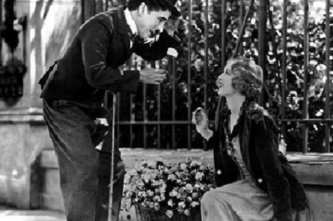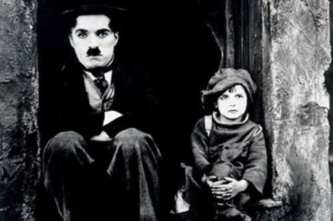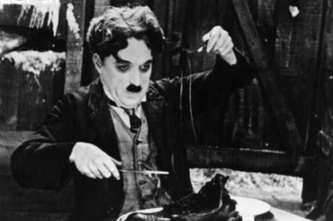
Best Charlie Chaplin Moments
Charlie Chaplin’s classics; Modern Times and The Gold Rush are released on dual edition (DVD and Blu-Ray in one boxset) from August 23rd.
Here we list our favourite film moments from one of comedy’s biggest stars.
Limelight
Whilst Chaplin was touring with The Limelight he was refused re-entry to the United States as part of the crack down on communist sympathisers during the McCarthyist period.
Memorable scene: The disastrous scene in which Buster Keaton and Charlie Chaplin attempt to perform as a musical duo; Calvero’s assistant and Calvero respectively.
Whilst the assistant fumbles with the music notes at the piano, Calvero’s height suffers the ups and downs of a car jack style leg; cranking up one moment and falling down to make him lop sided the next.
When the duo eventually performs Chaplin’s Calvero puts his gusto into a manic performance on the violin which even tumbling off stage and being stuck in a drum cannot stop.
Kid Auto Races At Venice
This was Chaplin’s second appearance on screen, but the first film in which his most memorable 'Little Tramp' character made an appearance. The film is set at the 'baby-cart races' in California and filmed during the Junior Vanderbilt Cup.
Memorable scene: Chaplin plays an interfering spectator who keeps getting in the way of the cameras attempting to film the race.
City Lights
Despite the dwindling popularity for silent films, City Lights was immediately well received and is remembered as one of Chaplin’s most successful and prolific films.
The film centres around the running gag that the millionaire who Chaplin talks out of committing suicide is his best friend while drunk until he sobers up and doesn’t remember him.
Memorable scene: The Tramp accidently enters the boxing ring. Aware of his small stature and inability to put in a good fight the tramp follows the movements of the referee; side stepping and pacing in time to avoid being knocked out by his burly opponent.
It is only when the referee changes his rhythm and the Tramp is suddenly exposed that he is forced to take action against the opposition; using the ropes to launch himself into the belly of this opponent in a wrestler like assault.

The Immigrant
Here Chaplin plays an immigrant entering the United States for the first time who falls in love with a fellow immigrant.
A notorious scene from The Immigrant features Chaplin kicking an immigration officer; this was later used against the comedy hero in the McCarthy era as an example of his 'anti-American' attitude.
Memorable scene: The almost infamous scene is the restaurant sequence in which the immigrant struggles to find enough money to pay for his and his companion’s plates of beans to avoid being attacked and forcibly ejected by the head waiter.
The Kid
This silent dramedy kick-started Chaplin’s golden era in 1921 and became the second highest grossing film of that year behind The Four Horesmen of the Apocalypse.
The adopted Kid is employed by the tramp to throw rocks at windows; when the windows are smashed the tramp appears from around the corner with a pane of glass.
Memorable scene: The Kid is about to throw a stone, he pulls back but literally feels the long arm of the law.
Aware of the danger directly behind him the kid cheekily grins at the policeman as he cradles the stone in his hands, treating the object to the tenderness shown to a pet whilst the policeman watches contently.
When the policeman leaves the scene the kid throws the stone at a window.

Monsieur Verdoux
Often described as being years ahead of its time, Monsieur Verdoux is a black comedy which depicts a unemployed banker and his sociopathic methods of obtaining income.
Memorable scene: Monsieur Verdoux’s seduction technique. Verdoux begins by showing a voluptuous homebuyer his marital bedroom which has remained empty since the death of his wife.
In midst of chasing the mature lady around the bedroom Verdoux becomes frantic as he spouts cheesy lines.
When the suitor is disturbed by a potential house buyer he pretends that he is protecting the woman from a bee with such enthusiasm that he falls out the window.
The Gold Rush
Chaplin has repeatedly declared that this is the film for which he most wants to be remembered. The Little Tramp in this film travels to Alaska to take part in the Alaska Gold Rush.
Memorable scene: Chaplin and his cabin-mate are starving: first they attempt to eat a stewed shoe and later the Tramp’s companion begins to deliriously imagine Chaplin as an oversized chicken.
This is a scene which has been parodied endlessly since and remains one of the most iconic scenes in comedy history.

The Circus
Despite the many catastrophes which occurred during the production of this film (including a studio fire, the death if Chaplin’s mother and a run-in with the IRS), The Circus is the seventh highest grossing silent film, earning $ 3.8 million in 1928.
Memorable scene: The Little Tramp is on the run from the law, and seeks refuge under a circus tent where he unintentionally interrupts the clown act to great comedic effect.
The ringmaster then employs him as a clown, only to discover the Little Tramp can only be funny unintentionally.
Modern Times
This 1936 comedy sees the iconic Little Tramp struggling to survive in the modern, industrialised world, providing a comment on the social and fiscal situation during the Great Depression. The film is notable as the last film to feature The Little Tramp.
Memorable scene: The Tramp, having tightened so many bolts is unable to shake off this robotic movement thus symbolising how the machine has infected the man.
Charlie Chaplin’s classics; Modern Times and The Gold Rush are released on dual edition (DVD and Blu-Ray in one boxset) from August 23rd.
Here we list our favourite film moments from one of comedy’s biggest stars.
Limelight
Whilst Chaplin was touring with The Limelight he was refused re-entry to the United States as part of the crack down on communist sympathisers during the McCarthyist period.
Memorable scene: The disastrous scene in which Buster Keaton and Charlie Chaplin attempt to perform as a musical duo; Calvero’s assistant and Calvero respectively.
Whilst the assistant fumbles with the music notes at the piano, Calvero’s height suffers the ups and downs of a car jack style leg; cranking up one moment and falling down to make him lop sided the next.
When the duo eventually performs Chaplin’s Calvero puts his gusto into a manic performance on the violin which even tumbling off stage and being stuck in a drum cannot stop.
Kid Auto Races At Venice
This was Chaplin’s second appearance on screen, but the first film in which his most memorable 'Little Tramp' character made an appearance. The film is set at the 'baby-cart races' in California and filmed during the Junior Vanderbilt Cup.
Memorable scene: Chaplin plays an interfering spectator who keeps getting in the way of the cameras attempting to film the race.
City Lights
Despite the dwindling popularity for silent films, City Lights was immediately well received and is remembered as one of Chaplin’s most successful and prolific films.
The film centres around the running gag that the millionaire who Chaplin talks out of committing suicide is his best friend while drunk until he sobers up and doesn’t remember him.
Memorable scene: The Tramp accidently enters the boxing ring. Aware of his small stature and inability to put in a good fight the tramp follows the movements of the referee; side stepping and pacing in time to avoid being knocked out by his burly opponent.
It is only when the referee changes his rhythm and the Tramp is suddenly exposed that he is forced to take action against the opposition; using the ropes to launch himself into the belly of this opponent in a wrestler like assault.

The Immigrant
Here Chaplin plays an immigrant entering the United States for the first time who falls in love with a fellow immigrant.
A notorious scene from The Immigrant features Chaplin kicking an immigration officer; this was later used against the comedy hero in the McCarthy era as an example of his 'anti-American' attitude.
Memorable scene: The almost infamous scene is the restaurant sequence in which the immigrant struggles to find enough money to pay for his and his companion’s plates of beans to avoid being attacked and forcibly ejected by the head waiter.
The Kid
This silent dramedy kick-started Chaplin’s golden era in 1921 and became the second highest grossing film of that year behind The Four Horesmen of the Apocalypse.
The adopted Kid is employed by the tramp to throw rocks at windows; when the windows are smashed the tramp appears from around the corner with a pane of glass.
Memorable scene: The Kid is about to throw a stone, he pulls back but literally feels the long arm of the law.
Aware of the danger directly behind him the kid cheekily grins at the policeman as he cradles the stone in his hands, treating the object to the tenderness shown to a pet whilst the policeman watches contently.
When the policeman leaves the scene the kid throws the stone at a window.

Monsieur Verdoux
Often described as being years ahead of its time, Monsieur Verdoux is a black comedy which depicts a unemployed banker and his sociopathic methods of obtaining income.
Memorable scene: Monsieur Verdoux’s seduction technique. Verdoux begins by showing a voluptuous homebuyer his marital bedroom which has remained empty since the death of his wife.
In midst of chasing the mature lady around the bedroom Verdoux becomes frantic as he spouts cheesy lines.
When the suitor is disturbed by a potential house buyer he pretends that he is protecting the woman from a bee with such enthusiasm that he falls out the window.
Tagged in Charlie Chaplin

